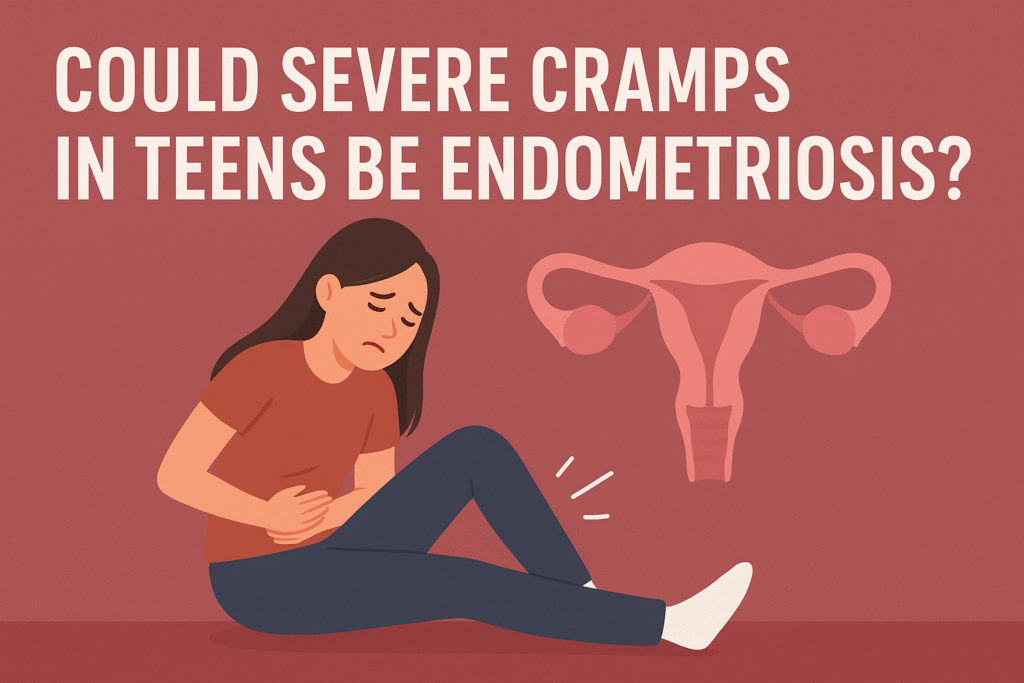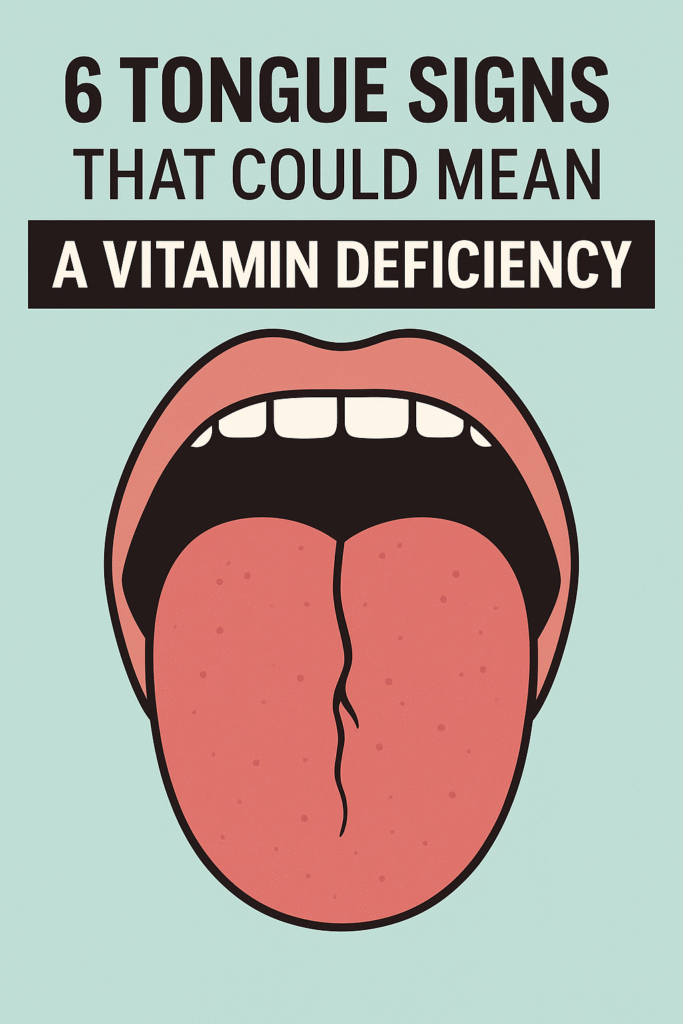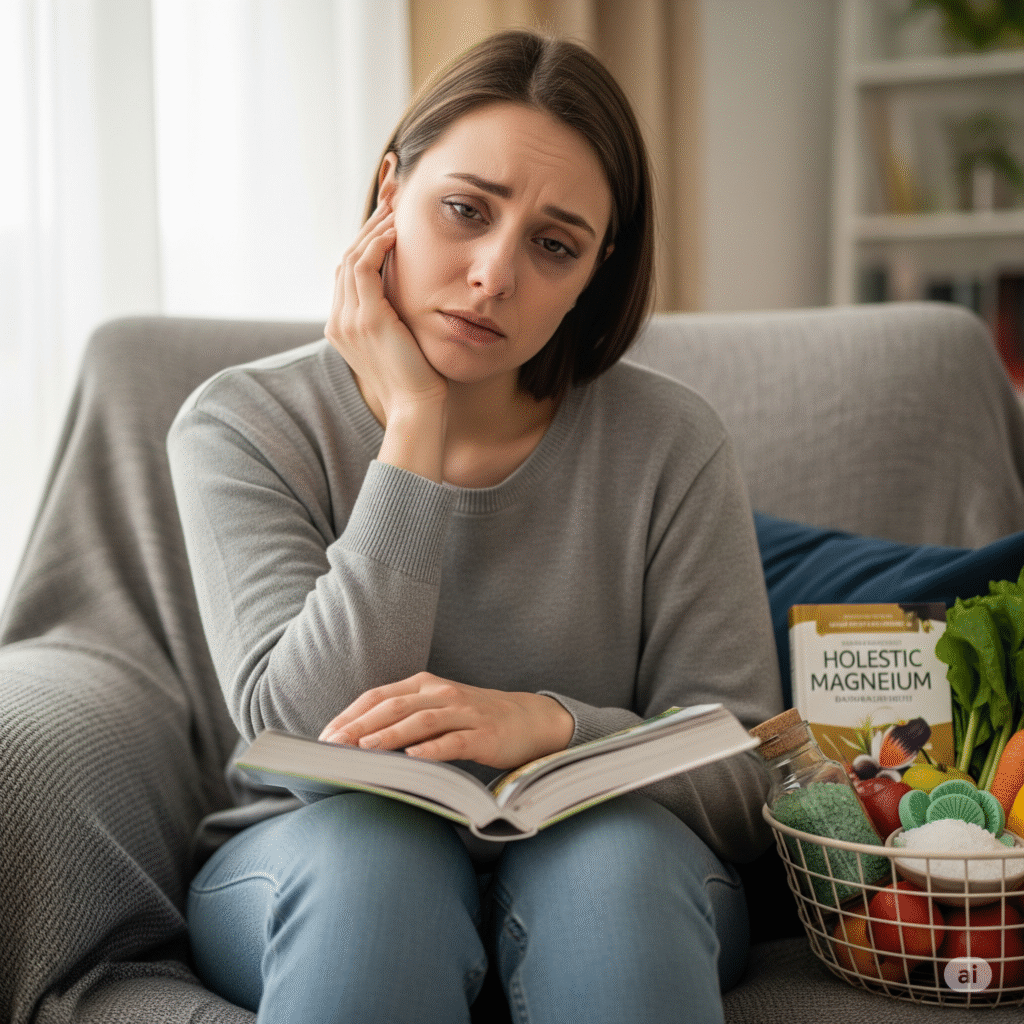
⚠️ Affiliate Disclaimer: This post may contain affiliate links, which means I may earn a small commission — at no extra cost to you — if you make a purchase through one of these links. I only recommend products or services I genuinely trust and believe can provide value. Thank you for supporting My Medical Muse!
7 Powerful Signs Severe Cramps in Teens Could Be Endometriosis
Could Severe Cramps in Teens Be Endometriosis? Signs Beyond “Normal” Cramps
Menstrual cramps are often considered a normal part of adolescence, for many teens, they are an expected monthly nuisance that can usually be managed with rest, a heating pad, or over-the-counter medication. When period pain becomes so severe that it interrupts school, sports, social activities, or even basic daily functioning, it may be a sign of something more serious than “just cramps.”
For some teenagers, these debilitating episodes are early signs of endometriosis, a chronic, often misunderstood condition in which tissue similar to the lining of the uterus grows outside the womb. Endometriosis doesn’t just cause painful periods; it can also affect digestion, energy levels, mental health, and long-term fertility. Unfortunately, because severe menstrual pain is frequently dismissed as “normal,” many young people go undiagnosed for years.
Understanding the difference between routine discomfort and symptoms that could signal disease is crucial, With early recognition, teens can receive appropriate care, avoid years of unnecessary suffering, and take control of their reproductive health.
In this article, we’ll explore:
- How to tell the difference between normal menstrual cramps and endometriosis cramp.
- The specific signs of endometriosis in teens that go beyond typical period discomfort.
- Why early diagnosis matters
- What steps parents, caregivers, and teens themselves can take to seek proper evaluation and support
Understanding Normal vs. Severe Cramps
Almost every teenager will experience some level of dysmenorrhea (the medical term for menstrual cramps) after menstruation begins. These cramps are caused by uterine contractions, triggered by hormone-like chemicals known as prostaglandins. Higher prostaglandin levels are linked to stronger uterine contractions and more pain.
- Mild cramps often feel like a dull ache, heaviness, or pressure in the lower abdomen. They may last a few hours to a couple of days and usually improve with rest, hydration, heat therapy, or over-the-counter pain relievers.
- Moderate cramps can radiate to the lower back, hips, or thighs. They’re uncomfortable but usually manageable with medication like ibuprofen or naproxen, and they rarely prevent teens from going about daily life.
For many, this is the typical range of menstrual discomfort, unpleasant, but not disabling.
However, severe cramps are different. They:
- Begin before bleeding starts and can persist throughout the entire period
- Cause sharp or stabbing pain that is not relieved by common remedies
- Lead to additional symptoms such as nausea, vomiting, diarrhea, or lightheadedness
- Interfere with school, sports, or social activities
- Sometimes require stronger medications just to function
At this level, the pain is not simply “a bad period.” Instead, it could indicate an underlying condition like endometriosis, one that deserves medical attention rather than dismissal. Recognizing this early can make all the difference in a teen’s quality of life and long-term health.
What Is Endometriosis?
Endometriosis is a chronic, inflammatory condition that affects millions of people worldwide. It occurs when tissue similar to the endometrium (the lining of the uterus) grows outside the uterus where it doesn’t belong. These growths, often called lesions or implants, can be found on the:
- Ovaries
- Fallopian tubes
- Outer surface of the uterus
- Pelvic wall and surrounding tissues
- In rare cases, even beyond the pelvic region (such as the bladder, intestines, or diaphragm)
Although this tissue is outside the uterus, it still responds to hormonal changes during the menstrual cycle. Just like the uterine lining, it thickens, breaks down, and bleeds each month, but unlike menstrual blood, this displaced tissue has no way to exit the body. The result is:
- Painful inflammation that can cause swelling and irritation
- Internal bleeding during each cycle, even if microscopic
- Scar tissue and adhesions, which may cause organs to stick together
- Potential fertility complications over time
Endometriosis is not just “bad periods.” It is a systemic disease that can affect the entire body, impacting physical, emotional, and social well-being.
Globally, an estimated 1 in 10 women of reproductive age lives with endometriosis. Even more concerning, symptoms frequently begin in adolescence. Yet, despite its prevalence, diagnosis is often delayed for 7-10 years. Why? Because painful periods in teenagers are too often dismissed as “normal,” leaving countless young people to suffer in silence.
Why Teens Are Often Misdiagnosed
For teenagers, one of the biggest barriers to timely diagnosis is medical and cultural normalization of pain. Many are told phrases like:
- “It’s just part of growing up.”
- “Lots of girls have bad cramps, you’ll outgrow it.”
- “It’s normal to miss school or sports during your period.”
While well-meaning, these statements can be incredibly harmful. They invalidate a teen’s experience and send the message that suffering is simply part of womanhood. As a result, warning signs of endometriosis are often overlooked.
This dismissal has real consequences:
- Missed opportunities for early detection: By the time teens receive a diagnosis, the disease may have progressed.
- Years of untreated pain: Teens may learn to normalize or hide their suffering, further delaying help.
- Academic and social struggles: Repeated absences from school, missed exams, and withdrawal from sports or friendships can affect self-esteem and long-term opportunities.
- Emotional burden: Constant pain without answers can lead to frustration, anxiety, or depression.
Research highlights this reality, around 70% of women who are eventually diagnosed with endometriosis recall having symptoms during their teenage years. This means that the teenage years are not only a common starting point for symptoms but also a critical window for intervention.
If parents, teachers, and healthcare providers can recognize these red flags earlier, we can change a teen’s health trajectory, preventing years of unnecessary suffering and empowering them with treatment options much sooner.
Signs of Endometriosis in Teens (Beyond Normal Cramps)
While menstrual cramps are common, the intensity, duration, and associated symptoms of endometriosis-related pain are very different. Teens with endometriosis often experience a cluster of issues that go far beyond “normal period pain.” Recognizing these warning signs early can help families seek medical evaluation before years of suffering pass.
Here are the key symptoms that may suggest endometriosis in teenagers:
1. Debilitating Menstrual Pain
Unlike ordinary cramps, endometriosis pain can be intense, unrelenting, and resistant to common remedies.
- Pain so severe that rest, heating pads, or over-the-counter medications like ibuprofen don’t bring relief
- Cramps that are disabling enough to cause school absences, missed sports practices, or withdrawal from social activities
- Pain that starts days before bleeding begins and lasts throughout the period, not just on day one
This level of pain is not just “a heavy flow” or “a bad period” , it may be the body signaling that something deeper is wrong.
2. Heavy Menstrual Bleeding
Another hallmark of endometriosis is abnormally heavy or prolonged menstrual bleeding. Teens may notice:
- The need to change pads or tampons every 1-2 hours
- Periods that last longer than 7 days
- Passing large or frequent blood clots
Heavy bleeding not only disrupts daily life but can also lead to iron deficiency anemia, leaving teens feeling exhausted and weak.
3. Pain Beyond Periods
Endometriosis isn’t confined to the menstrual window. Teens may experience pain throughout the cycle, making it harder to connect symptoms directly to periods.
- Pelvic or abdominal pain between menstrual cycles
- Sharp pain during bowel movements or urination, particularly around menstruation
- Pain during physical activity or exercise and in older teens, pain during or after sexual activity
These types of pain are often misattributed to digestive issues, urinary tract infections, or even “growing pains.”
4. Gastrointestinal Issues
Because endometriosis often affects areas near the intestines or bladder, it can mimic other conditions. Many teens are mistakenly told they have IBS (Irritable Bowel Syndrome) instead.
- Cyclical bloating, constipation, diarrhea, or nausea that worsens during periods
- Abdominal cramping that doesn’t align with typical digestive disorders
- Symptoms that flare up monthly rather than being constant, as is more typical with IBS
This overlap is one reason diagnosis is delayed both teens and doctors may look in the wrong direction first.
5. Chronic Fatigue
Living with constant or recurring pain drains the body’s energy reserves. Teens with endometriosis often describe deep, unrelenting fatigue:
- Extreme tiredness that isn’t relieved by rest or sleep
- Difficulty concentrating in class due to exhaustion
- A decline in academic or athletic performance because of low energy levels
This fatigue is more than just being “tired from your period.” It is a systemic effect of chronic pain and inflammation.
6. Family History
Genetics play a strong role in endometriosis. A teen whose mother, sister, or aunt has the condition faces a higher likelihood of developing it as well, while family history alone doesn’t guarantee a diagnosis, it is an important risk factor that doctors should take seriously.
When to Suspect It’s Not “Normal”
Because cramps are so common, it can be difficult to know when they cross the line into something that requires medical attention. A helpful way to differentiate is to ask these key questions:
- Does pain cause frequent school absences or missed activities?
- Do common painkillers like ibuprofen or naproxen provide little to no relief?
- Does pain begin before the period and linger long after bleeding stops?
- Are there digestive or urinary symptoms that get worse around menstruation?
- Does pain significantly limit everyday functioning or quality of life?
If the answer is “yes” to several of these questions, it’s a strong signal that the cramps may not be “normal” at all. Instead, they could point toward endometriosis and that deserves proper evaluation by a healthcare professional.
Emotional and Social Impact on Teens
Endometriosis is not just a physical condition, for teens, the effects often extend far beyond the body, deeply influencing emotional well-being, academic performance, and social relationships.
- Academic struggles: Missing school regularly due to severe cramps or fatigue can lead to falling behind in classes, missing exams, or struggling with attendance requirements. Over time, this can lower confidence and affect long-term educational opportunities.
- Social withdrawal: Teens may start avoiding sports, clubs, or hanging out with friends because of unpredictable pain flare-ups or heavy bleeding. This isolation can create feelings of loneliness or the fear of being misunderstood.
- Emotional toll: Living with unrelenting pain can lead to anxiety, frustration, or depression. Many teens also feel invisible when their symptoms are dismissed as exaggeration or “normal,” which can worsen emotional distress.
- Trust in healthcare: When repeated visits to doctors end with reassurance but no answers, teens may lose faith in the medical system. This discourages them from seeking help when they need it most.
Acknowledging the emotional burden of endometriosis is just as important as addressing the physical pain. Early recognition and treatment not only reduce physical suffering but also help safeguard mental health, resilience, and self-esteem during these formative years.
The Diagnostic Journey: Why It’s Challenging
Getting a diagnosis for endometriosis in teens is notoriously difficult. Part of the challenge lies in the fact that the symptoms overlap with many other conditions, and part lies in the reluctance to investigate aggressively at a young age.
Common diagnostic challenges:
- Symptom overlap: Endometriosis can mimic conditions such as Irritable Bowel Syndrome (IBS), urinary tract infections, or pelvic inflammatory disease, leading doctors to misdiagnose or delay further investigation.
- Pelvic exams: These may be uncomfortable or inconclusive in adolescents, making them less useful in early evaluations.
- Gold standard is invasive: A laparoscopy, a minimally invasive surgery that allows doctors to see and biopsy endometrial lesions, is the only way to confirm endometriosis with certainty. However, doctors may hesitate to recommend surgery for younger patients unless symptoms are severe.
How doctors often proceed instead:
- Detailed symptom history: Tracking the onset, severity, and pattern of symptoms over time.
- Family medical history: Considering whether close relatives also have endometriosis, which raises the likelihood.
- Response to treatments: Trial use of NSAIDs or hormonal therapy to see if symptoms improve, which can support (but not confirm) a suspected diagnosis.
This cautious approach often delays diagnosis, but it highlights why symptom tracking and persistence in seeking care are so vital for teens and their families.
Treatment Options for Teens
While there is currently no cure for endometriosis, a range of treatments can manage symptoms, slow disease progression, and improve quality of life. Treatment plans are highly individualized, depending on a teen’s age, lifestyle, and severity of symptoms.
1. Pain Management
- NSAIDs like ibuprofen or naproxen reduce inflammation and ease menstrual cramps.
- Heat therapy (heating pads, warm baths, or heat patches) helps relax pelvic muscles and provides comfort during flare-ups.
2. Hormonal Therapies
Hormonal medications suppress the menstrual cycle to reduce the growth and activity of endometrial lesions. Options include:
- Combined oral contraceptives (the pill), patches, or rings
- Progesterone-only methods, such as IUDs, injections, or implants
- Hormonal suppression therapy in severe cases, to reduce estrogen production and slow lesion growth
3. Surgical Intervention
- Laparoscopic surgery may be recommended for severe cases or when symptoms don’t respond to other treatments. Surgeons can remove or destroy endometriotic lesions and adhesions, which often improves pain and may help preserve fertility in the future.
4. Lifestyle & Supportive Therapies
- Diet adjustments: Reducing processed foods, caffeine, and sugar while increasing anti-inflammatory foods like fruits, vegetables, omega-3s, and whole grains.
- Stress management: Practices such as yoga, meditation, or mindfulness can help reduce the impact of chronic pain on mental health.
- Counseling or therapy: Professional mental health support can help teens cope with the emotional challenges of living with a chronic condition.
- Support groups: Talking to others who share similar experiences can provide validation and reduce feelings of isolation.
Why Early Diagnosis Matters
Delaying a diagnosis of endometriosis can have serious, long-lasting consequences. The longer the condition goes untreated, the more severe its impact can become:
- Worsening pain that becomes harder to control over time
- Spread of lesions and adhesions, which may complicate treatment and cause organ damage
- Higher risk of infertility later in life, especially if the condition progresses untreated
- Emotional trauma, as years of pain and dismissal can erode trust in healthcare and contribute to depression or anxiety
Conversely, early diagnosis offers powerful benefits:
- Effective pain management and relief from symptoms
- Improved academic and social participation, reducing school absences and helping teens maintain normalcy in daily life
- Preservation of fertility options, giving young women more choices for the future
- Validation and emotional support, helping teens feel heard, understood, and empowered
The earlier endometriosis is recognized, the greater the chance of minimizing its impact on both physical health and overall quality of life.
What Parents and Teens Can Do
When a teen is experiencing severe menstrual cramps or other symptoms of endometriosis, it can be overwhelming for both the teen and their family. The good news is that there are practical steps parents and teens can take together to better understand symptoms, seek proper care, and advocate for early diagnosis.
1. Track Symptoms Consistently
Keeping a record of symptoms is one of the most powerful tools in the diagnostic journey. A detailed log can help doctors identify patterns that distinguish normal menstrual pain from potential endometriosis.
- Use a period-tracking app or a physical journal.
- Record pain intensity daily on a scale from 1-10.
- Note the duration of pain and whether it occurs before, during, or after menstruation.
- Track bleeding patterns, including heaviness, clots, or spotting.
- Document digestive and urinary symptoms (such as constipation, bloating, or pain when urinating).
- Keep a note of school absences or missed activities due to pain.
Over time, these records provide valuable evidence that can guide healthcare providers toward a more accurate diagnosis.
2. Seek Specialized Care
Not all doctors are equally experienced in recognizing adolescent endometriosis. If a teen’s symptoms are severe or persistent, parents should:
- Ask for a referral to a gynecologist who specializes in adolescents or one with expertise in endometriosis.
- Be prepared to seek a second opinion if concerns are dismissed.
- Remember that early referral can prevent years of pain and delay in care.
3. Advocate for Validation
One of the most important things families can do is to take a teen’s pain seriously. Too often, young people are told: “That’s just part of being a woman.” This mindset invalidates real suffering and contributes to diagnostic delays.
- Remind teens that severe pain is not normal and deserves medical attention.
- Encourage open conversations about symptoms without shame.
- Be persistent in advocating for answers, trust your instincts as a parent or as a teen who knows their own body.
4. Educate Schools and Support Networks
School absences and performance struggles can add unnecessary stress to a teen already dealing with pain. Teachers and administrators need to understand how endometriosis affects students.
- Share information about the condition with teachers, school nurses, and counselors.
- Request accommodations such as flexibility with attendance, extra time for assignments, or rest breaks when needed.
- Encourage schools to foster a culture where period pain is not trivialized, helping reduce stigma for all students.
With understanding and adjustments, schools can play a supportive role in helping affected teens maintain both their health and their education.
Myths vs. Facts About Endometriosis in Teens
Misinformation is one of the biggest barriers to early recognition of endometriosis. By separating myths from facts, parents and teens can be better equipped to advocate for proper care.
Myth: “Teens are too young to have endometriosis.”
- Fact: Endometriosis symptoms often begin shortly after menarche (the first period). Early-onset cases are well-documented, and dismissing them only delays treatment.
Myth: “Pregnancy will cure it.”
- Fact: While pregnancy may temporarily suppress symptoms due to hormonal changes, it does not cure endometriosis. Once hormone levels return to normal, symptoms often reappear.
Myth: “Birth control pills cure endometriosis.”
- Fact: Hormonal therapies like birth control pills can help manage symptoms and slow disease progression, but they do not eliminate the condition. Endometrial lesions may remain or continue growing.
Myth: “It’s rare.”
- Fact: Endometriosis is common , affecting up to 1 in 10 women worldwide. Many report their first symptoms during adolescence, making it far from a rare disease.
Understanding these truths helps break down stigma and empowers families to seek proper care rather than accept misinformation.
The Role of Awareness and Advocacy
The conversation around teen endometriosis is growing, but stigma and misinformation remain barriers. Advocacy efforts by organizations like the Endometriosis Foundation of America and Endometriosis UK are crucial.
Spreading awareness helps:
- Reduce diagnostic delays.
- Empower teens to seek help.
- Push for more research and treatment options.
Key Takeaways
- Severe cramps in teens are not always “normal.” Persistent, intense, or disabling pain should raise concern for endometriosis.
- Endometriosis often begins in adolescence. Early symptoms may include not only cramps but also heavy bleeding, digestive issues, fatigue, and pain outside of periods.
- Diagnosis is frequently delayed. Many teens are told they are “too young” or that pain is “just part of being a woman,” leading to years of unnecessary suffering.
- Early recognition and intervention matter. Prompt medical care can reduce pain, preserve fertility, improve academic and social participation, and safeguard emotional health.
- Support makes a difference. Parents, schools, and healthcare providers all play a crucial role in validating symptoms, providing accommodations, and helping teens access proper care.
Conclusion
Endometriosis is often described as an “invisible illness,” but for teens, its impact is anything but invisible. Behind every school absence, every missed sports practice, and every sleepless night is a young person coping with pain that too often goes unrecognized.
When menstrual cramps are so severe that they disrupt education, social life, or mental health, they should never be brushed aside as “just part of growing up.” For many teenagers, these are the first red flags of endometriosis, a chronic condition that deserves attention, validation, and comprehensive care.
By recognizing the warning signs early, parents and teens can push past stigma and seek the specialized care that makes a real difference with proper treatment and support, teens can regain control of their health, rebuild confidence, and look forward to a future not defined by pain.
Ultimately, awareness is the first step toward change. By listening, believing, and acting, we can ensure that teenagers living with endometriosis receive the compassion, medical care, and hope they truly deserve.
👩⚕️ Need Personalized Health Advice?
Get expert guidance tailored to your unique health concerns through MuseCare Consult. Our licensed doctors are here to help you understand your symptoms, medications, and lab results—confidentially and affordably.
👉 Book a MuseCare Consult NowRelated Blog Post You Might Like:
- Birth Control Pill and Low Libido: 7 Surprising Facts Every Woman Should Know
- 8 Powerful Reasons Why Am I Getting UTIs All the Time Despite Good Hygiene
- How Long Before Estrogen Cream Works: 3 Proven Timelines for Vaginal Dryness Relief
- 10 Powerful Facts About Hormonal Contraceptives You Must Know
- Mid-Cycle Spotting Explained: 10 Key Facts About Ovulation Bleeding


